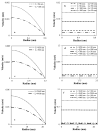Research Progress on Micro/Nanopore Flow Behavior
- PMID: 40333764
- PMCID: PMC12029943
- DOI: 10.3390/molecules30081807
Research Progress on Micro/Nanopore Flow Behavior
Abstract
Fluid flow in microporous and nanoporous media exhibits unique behaviors that deviate from classical continuum predictions due to dominant surface forces at small scales. Understanding these microscale flow mechanisms is critical for optimizing unconventional reservoir recovery and other energy applications. This review provides a comparative analysis of the existing literature, highlighting key advances in experimental techniques, theoretical models, and numerical simulations. We discuss how innovative micro/nanofluidic devices and high-resolution imaging methods now enable direct observation of confined flow phenomena, such as slip flow, phase transitions, and non-Darcy behavior. Recent theoretical models have clarified scale-dependent flow regimes by distinguishing microscale effects from macroscopic Darcy flow. Likewise, advanced numerical simulations-including molecular dynamics (MD), lattice Boltzmann methods (LBM), and hybrid multiscale frameworks-capture complex fluid-solid interactions and multiphase dynamics under realistic pressure and wettability conditions. Moreover, the integration of artificial intelligence (e.g., data-driven modeling and physics-informed neural networks) is accelerating data interpretation and multiscale modeling, offering improved predictive capabilities. Through this critical review, key phenomena, such as adsorption layers, fluid-solid interactions, and pore surface heterogeneity, are examined across studies, and persistent challenges are identified. Despite notable progress, challenges remain in replicating true reservoir conditions, bridging microscale and continuum models, and fully characterizing multiphase interface dynamics. By consolidating recent progress and perspectives, this review not only summarizes the state-of-the-art but underscores remaining knowledge gaps and future directions in micro/nanopore flow research.
Keywords: artificial intelligence; confined flow behavior; experimental research; lattice Boltzmann method; microseepage; molecular dynamics simulation; nanoporous media; pore-scale modeling.
Conflict of interest statement
All authors were employed by PetroChina Company Limited. They declare that the research was conducted in the absence of any commercial or financial relationships that could be construed as a potential conflict of interest.
Figures







Similar articles
-
Pore-scale modeling of two-phase flow: A comparison of the generalized network model to direct numerical simulation.Phys Rev E. 2023 Mar;107(3-2):035107. doi: 10.1103/PhysRevE.107.035107. Phys Rev E. 2023. PMID: 37073001
-
Multiphase displacement manipulated by micro/nanoparticle suspensions in porous media via microfluidic experiments: From interface science to multiphase flow patterns.Adv Colloid Interface Sci. 2023 Jan;311:102826. doi: 10.1016/j.cis.2022.102826. Epub 2022 Dec 13. Adv Colloid Interface Sci. 2023. PMID: 36528919 Review.
-
Multiscale modeling of gas flow behaviors in nanoporous shale matrix considering multiple transport mechanisms.Phys Rev E. 2022 May;105(5-2):055308. doi: 10.1103/PhysRevE.105.055308. Phys Rev E. 2022. PMID: 35706209
-
Exploring Anomalous Fluid Behavior at the Nanoscale: Direct Visualization and Quantification via Nanofluidic Devices.Acc Chem Res. 2020 Feb 18;53(2):347-357. doi: 10.1021/acs.accounts.9b00411. Epub 2020 Jan 10. Acc Chem Res. 2020. PMID: 31922716
-
Hydrocarbon migration and accumulation simulation: A review and a novel multi-scale quantitative numerical simulation method.Adv Colloid Interface Sci. 2025 Aug;342:103523. doi: 10.1016/j.cis.2025.103523. Epub 2025 Apr 27. Adv Colloid Interface Sci. 2025. PMID: 40318382 Review.
References
-
- Li L., Zhang D., Su Y., Zhang X., Lu M., Wang H. Microfluidic Insights into CO2 Sequestration and Enhanced Oil Recovery in Laminated Shale Reservoirs: Post-Fracturing Interface Dynamics and Micro-Scale Mechanisms. Adv. Geo-Energy Res. 2024;13:203–217. doi: 10.46690/ager.2024.09.06. - DOI
-
- Han B., Wang S., Zhang Z., Wang Y. Numerical Simulation of Geothermal Reservoir Thermal Recovery of Heterogeneous Discrete Fracture Network-Rock Matrix System. Energy. 2024;305:132306. doi: 10.1016/j.energy.2024.132306. - DOI
-
- Jangda Z., Menke H., Busch A., Geiger S., Bultreys T., Lewis H., Singh K. Pore-Scale Visualization of Hydrogen Storage in a Sandstone at Subsurface Pressure and Temperature Conditions: Trapping, Dissolution and Wettability. J. Colloid Interface Sci. 2023;629:316–325. doi: 10.1016/j.jcis.2022.09.082. - DOI - PubMed
-
- Hou Y., Deng H., Pan F., Chen W., Du Q., Jiao K. Pore-Scale Investigation of Catalyst Layer Ingredient and Structure Effect in Proton Exchange Membrane Fuel Cell. Appl. Energy. 2019;253:113561. doi: 10.1016/j.apenergy.2019.113561. - DOI
-
- Chang Y., Yang Z., Zhang Y., Niu Z., Chen X. Micro-Nano Scale Confined Flow Characteristics and Mechanism in Tight Reservoir: Insights from Experimental and Molecular Simulation Studies. Geoenergy Sci. Eng. 2023;231:212317. doi: 10.1016/j.geoen.2023.212317. - DOI
Publication types
Grants and funding
LinkOut - more resources
Full Text Sources

